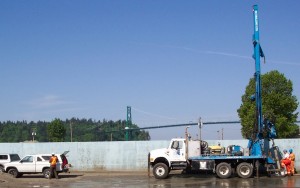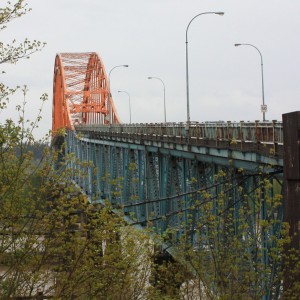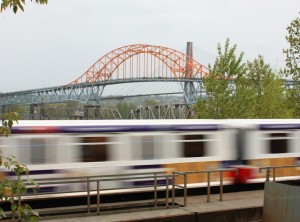This is similar in tone to an earlier post I wrote regarding the misapplication of technology. In that post, I questioned how “on-line voting” was going to fix the low turn-out rates in elections. The problem of low voter turn-out was not caused by the lack of options or access to polling booths, so increasing that access through the wonder of the Internet was not really a sensible solution. It was the wrong tool addressing the problem from the wrong direction.
This time, I hope to convince you that increasing the volume of traffic is not the solution to the problem of an aging bridge.
In earlier stages of my career, I had plenty of opportunities to work with drillers. Guys (and yes, they were all guys) who operate drilling equipment are a special breed. It is hard work, intensely physical, dirty, noisy, and you are doing it in the rain, the sleet, the snow, and any other unpleasant environment you are asked. Days are usually 12 hours, and you spend much of your off time living in flea-bag hotels on the outskirts of towns you wouldn’t otherwise visit.
I have drilled (actually, stood there watching other guys drill while I sketched on a clipboard and put samples into jars) in pounding down rain in February in Port Alice, in frozen sleet in September in Wells; In heavy snow in Anahim Lake, and on bright sunny warm days while standing on bulk sulphur storage piles. I have even stood on a small barge in Burrard Inlet in the middle of winter with drillers running a Pionjar off the side. With all of these conditions, they are operating a piece of equipment that can kill or maim them instantly if they lose attention. As a result, drillers are tough, skilled, determined, crude and practical: Every edge they have is rough. They all smoke every cigarette like it is their last; I have never seen a group of people so enthusiastic about smoking, and I grew up in a Pulp Mill town.
 |
| L to R: me, a notable bridge, a Sonic drill rig. |
All that aside, one of the charming things about drillers is their tool kit. It contains two types of tools: hammers, and unused. There is nothing a driller cannot fix with a hammer. If there is, it needed replacing anyway. Every process in the instruction book “Drilling for Dummies” starts with these two steps: 1) Get a hammer; 2) No, a bigger hammer.
As a result, drillers generally have a lot of broken and bent equipment around. When something goes wrong on the drill rig there are two ways it can go: lots of banging and then back to work; or lots of banging then back to the shop. The only shocking past is how often it is the former.
There is a truism called the Law of the Instrument, which is colloquially “when all you have is hammers, every problem looks like a nail”.
When applied to how our province has been operating its roads, and overseeing Translink’s management of the Major Road Network (including the Pattullo Bridge), it could be said that there is no problem that cannot be fixed by building more roads. Never mind what the problem is, or whether this solution has worked in the past, building more roads seems to be the one thing upon which this government has no problem spending taxpayers money.
If the connection isn’t obvious, let me put it this way: At a time when they are cutting back on bus routes and are putting all transit expansion on hold, TransLink is fast-tracking the “consultation” on the Pattullo, saying they need a new 6-lane bridge PDQ. This seems to be the solution to some problem, but there problem isn’t “traffic” or “truck movement” or “growing communities” (the talking points used to justify a 6-lane bridge). Their problem is an aging bridge.
Look at the “Replacement Factors” listed on their website for the project, what do we find? An alliterative list: Safety, Structure, Seismic, and Scour.
“Safety” issues are related to traffic operations on the bridge: lanes too narrow, inadequate railings, too many accidents. If TransLink or the Government was really concerned about driver safety on the bridge, they would put four photo radar cameras on the bridge and enforce the 50km/h speed limit. A revenue-generating end of the problem.
“Structure” arguments are all about corrosion of steel components on the bridge and degradation of the bridge deck, so exactly the same factors that led to the extensive refurbishment of the Lions Gate Bridge. There, things were repaired at a much lower cost than replacing the bridge.
“Seismic” seems pretty straight forward: a 1938 bridge does not meet 2012 earthquake standards. The Sandwell Report done for TransLink in 2007 was pretty clear: “…the bridge is vulnerable to collapse even under moderate earthquakes and is in urgent need of retrofitting.” So what are we waiting for? Let’s get on with that retrofitting and make a safe bridge, at a fraction of the cost of building a new bridge.
“Scour” is the argument that after 75 years, the River is now starting to scour away the sand and silt around the foundations of the bridge. Give me a couple of barges of 1-tonne rip-rap, and we can take care of the scour issue. No need for two lanes of extra traffic to fix this one.
Notably, not one of these “Replacement Factors” justify increasing the number of lanes on the bridge, and most can actually be facilitated at much lower cost by reducing the lanes to three (with counter-flow) like the Lions Gate. As compelling an argument TransLink makes for extensive refurbishment of the Pattullo Bridge, nothing that says we need to accept the negative impacts on the City and the region of increasing road capacity, or the loss of the iconic steel arch span that is part of our City’s heritage and skyline for 75 years. Nor do they justify ramping up a $200 Million refurbishment project into a $1Billion bridge expansion project.
However, bridge replacement and expansion is the hammer that TransLink has. Collecting tolls on the bridge is the force behind that hammer. So no surprise when the problem is an aging bridge, the solution is not fixing it. The solution is to imagine other problems that may be solved by expanding it and slapping on tolls.
Simply put: the Province will not pay $200 Million to upkeep the infrastructure it has, but will throw a bunch of money building other infrastructure with no plan for long-term maintenance costs.
Hardly a model of fiscal prudence in my book.


Good comment Pat. However TransLink is uniquely positioned in that they have more than one tool in the tool box. TransLink could equally deal with traffic issues in the Pattullo corridor by using one or more of the other tools they have at their disposal (probably transit and transportation demand management in the case).
While it might not be surprising that the Ministry of Transportation cannot think beyond their “more and more roads” policy, TransLink can choose to balance their existing offerings to optimize mode distribution to support our existing transportation infrastructure. Or if they must invest in more infrastructure to choose investments which support their long term goals (a la Transportation 2040, which is all about mode shift)
I won’t speculate here as to why they have chosen to spend a $billion (that they don’t have) on this road expansion project, but I am confident that the project they have proposed will make things worse.
Perhaps you are onto something, Andrew. Perhaps this is a symptom of another problem. Is TransLink operating with too many disconnected “silos”, with CMBC, SkyTrain, Canada Line, Community Shuttles, West Coast Express, Air Care, all fighting for their piece of the big (taxpayer) pie. The Roads Group (for lack of a better name, as there is no reference to roads and bridges in their corporate structure info on-line) needs a raison d’etre, and unfortunately, New West seems to be where they are concentrating their energy. They are the ones with building roads as their only tool, and to pass that funding off to one of the other groups would benefit them none…
Yes I would be critical of the TL “roads group”, if you can call it that. Other branches of TL seem to be much more enlightened, and I’m sure other departments are shaking their heads with projects such as UBE and the 6 lane Pattullo.
Unbelievable how they can seriously focus on local disconnected projects and expect to solve regional traffic problems.
Another problem with the “roads group” is that they see their mandate in goods movements as solely to facilitate trucks. This is another single tool solution (when other tools such as rail and barge are available). Its understandable that they don’t see their connection with the rail or barge companies as said companies tend to finance their own infrastructure. But by selectively supporting only one branch of the goods movement system they are not necessarily creating the most effective infrastructure investment.
I get your point. Analyzing those on your list, they all addressed the only existing problem — which is the aging bridge. However, if the bridge is getting older, and the materials used are starting to wear off, then it really has to be replaced. The idea itself would likely lessen the problem that would come in the future. But checking to see if there are other factors that can affect it wouldn’t hurt.
Jermaine Ryan @ Loadcraft Industries, Ltd.